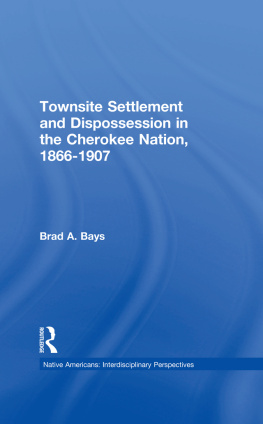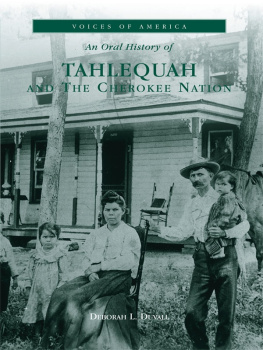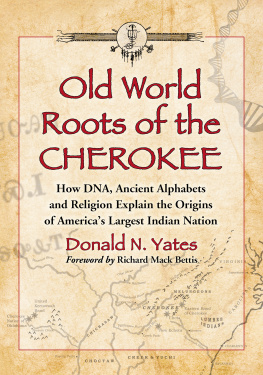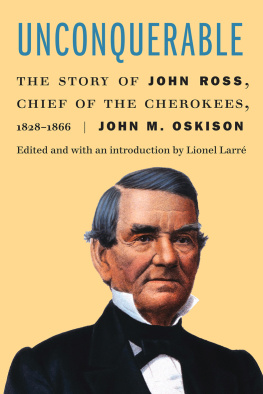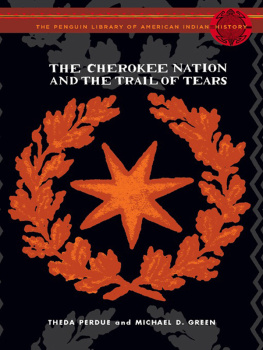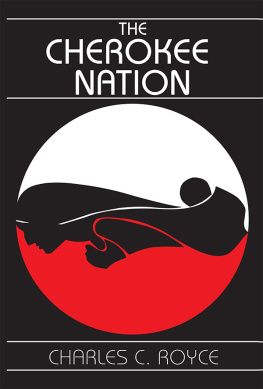First published 1998 by Garland Publishing, Inc.
This edition published 2015 by Routledge
711 Third Avenue, New York, NY 10017, USA
2 Park Square, Milton Park, Abingdon, Oxon, OX14 4RN
Routledge is an imprint of the Taylor & Francis Group, an informa business
Copyright 1998 Brad A. Bays
All rights reserved
Library of Congress Cataloging-in-Publication Data
Bays, Brad A., 1966
Townsite settlement and dispossession in the Cherokee
nation, 1866-1907 / Brad A. Bays.
p. cm. (Native Americans)
Includes bibliographical references and index.
ISBN 0-8153-2912-1 (alk. paper)
1. Cherokee IndiansLand tenure. 2. Cities and towns
Indian Territory. 3. Land tenureIndian Territory. I. Title.
II. Series: Native Americans (Garland Publishing, Inc.)
E99.C5B35 1997
976.6'0049755dc21
97-17753
ISBN 13: 978-0-8153-2912-1 (hbk)
Over and over again, the history of the relations between the American Indians and the United Statesor for that matter any indigenous people in the path of an expanding statecomes down to a matter of land. It is for this reason that the field of historical geography has great utility in unraveling and understanding the facts of the past in order to preserve the historical truths of U.S.-Indian relations.
The U.S. government's systematic assault on the communal land tenure systems of Indian nations stands out as perhaps the most significant process in the American engulfment of Indian societies and their lands. Through persuasion, coercion, and outright imposition, federal Indian policy in the last third of the nineteenth century revolved around dividing up commonly-held reservation lands. There were several official arguments used to justify allotment, from Lockeian attitudes about the right of modern society to exploit needed resources, to the turnabout that communal land systems enabled elite minorities to unfairly exploit a majority share of tribal resources. Whatever the argument, though, the motives behind the rhetoric were clear: white settlers and industrialists wanted access to Indian land and resources. Moreover, the parties involved (Indian people and government officials) realized this, yet the anomalous geopolitical and legal status of Indian nations prevented social justice from prevailing.
Plains Indian societies, many of whom were in dire straits by the 1870s after having lost population, most of their land, and nearly all their bison, were among the first peoples to be persuaded to divide their reservations and live like white farmers. Not only was this social experiment incredibly idealistic in terms of engineering cultural change, the methods and crops pushed on the Indians by eastern missionaries often just did not make any sense on the Great Plains. When whites made the run into the "surplus" lands of the recently-allotted Cheyenne and Arapaho Reservation on April 19, 1892, most of the land was claimed by ranchers, and many of the farmers who staked claims in the eastern part of the reservation failed financially or saw their topsoil blow away in the 1930s.
The so-called Dawes Act (1887) is usually cited as the law that imposed allotment upon the Indian nations who had until then rejected the idea even after the urging of government officials and missionaries to allot their lands. The Dawes Act, however, explicitly excluded the Five Civilized Tribesthe Cherokee, Mvskoke (Creek), Choctaw, Chickasaw, and Seminole Nationsfrom its requirements, thanks to the hard work of their Washington lobbyists and lawyers, a fact of history that substantiates the historical truth that allotment occurred because of the vested political interests driving it. Still, the government continued to try to publicly justify allotment as being best for the people of the Indian nations, but their land tenure systems worked for them, and they refused to comply. So Congress resorted to using its ultimate plenary power by passing the Curtis Act in 1898 and forcing the Five Tribes to allot against their will, which, as Angie Debo so straightforwardly described in And Still the Waters Run, led to a regional pattern of swindling and Indian impoverishment.
Debo's work, as well as that of another Oklahoman, Leslie Hewes, inspired the subject of this book while I was developing a dissertation topic at the University of Nebraska in the early 1990s. As I became more familiar with the historical geography of the Great Plains, my mental map of urban settlement never adequately filled in for my home state. Although neither focused much on the topic of townsite establishment and growth in the Indian Territory, the work of Hewes and Debo pointed me in the right direction. The complexity of the subject convinced me to limit my study to the Cherokee Nation, although there remains plenty of material for similar studies of the other four nations.
This book arrives on the centennial of the Curtis Act, a date that has vastly different meanings for Oklahomans. Whites in Tulsa and most other large towns in eastern Oklahoma are celebrating the year 1898 as the founding year of their towns, which is technically so, since the Curtis Act made it legal for whites living in the larger towns of Indian Territory to incorporate so that they could levy taxes for such luxuries as fire departments, sidewalks, and sewers. The date has a very different meaning, however, to my Cherokee and Mvskoke and Chickasaw friends, who mark it as the hundredth year of having lost the their nations' land bases. The truth is that many eastern Oklahoma towns existed long before 1898, and the processes of dispossession in the Indian Territory were protracted and exceedingly complex.
My intention here has been to merge the geographical understanding of town building processes with the facts of history to explain townsite settlement and dispossession in the Cherokee Nation. Any errors of fact or omission are my own. The result, I hope, is a clearer view of the past, which always helps our vision for the future.
B. A. B.
Stillwater, Okla.
March 1998
This book could not have been possible without the valued guidance of many people. In this respect, I owe an enormous debt of gratitude to David Wishart, a scholar and friend who was always there to provide advice and to bring up important questions about this research. I also owe a debt of gratitude to J. Clark Archer, an inquisitive and insightful political geographer. John R. Wunder, a historian with impeccable standards, provided me literary guidance and introduced me to rigorous historical research. Professor Stephen Lavin, a composer of maps, guided my retooling from pen and ink to mouse and laser printer. Professor Emeritus Leslie Hewes, a geographer's geographer and Cherokee scholar, also provided valuable, meticulous criticism of the manuscript.
Research for this work was generously funded by two Research Grants-in-Aid from the Center for Great Plains Studies at the University of Nebraska-Lincoln. The Department of Geography at the University of Nebraska-Lincoln also supported my work through graduate teaching stipends for three consecutive years, including summers. I owe a debt of gratitude to Dr. Kathleen Byrd, Chair, Department of Social Sciences, Northwestern State University of Louisiana, who hired me for my first tenure-track job while I continued work on this project.



